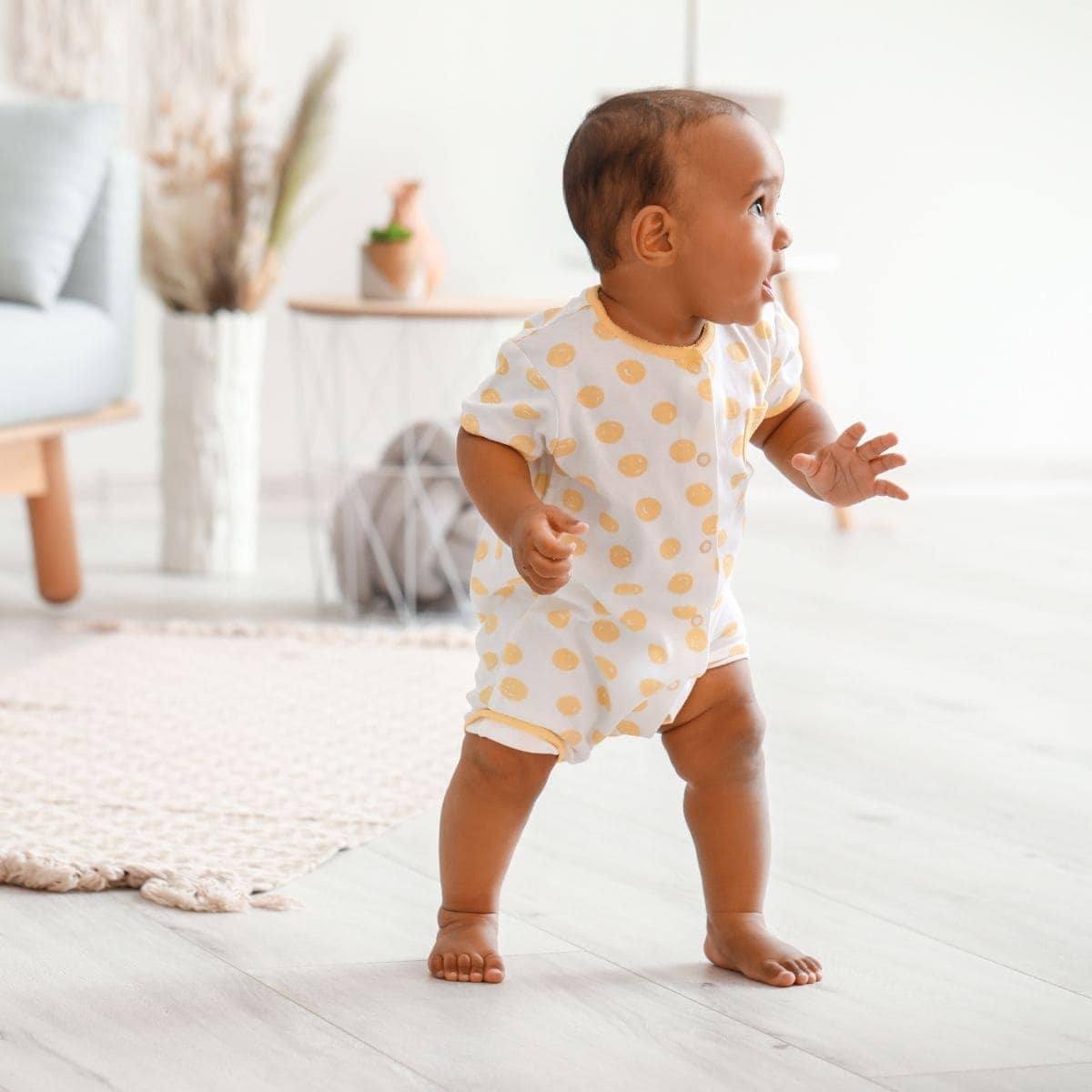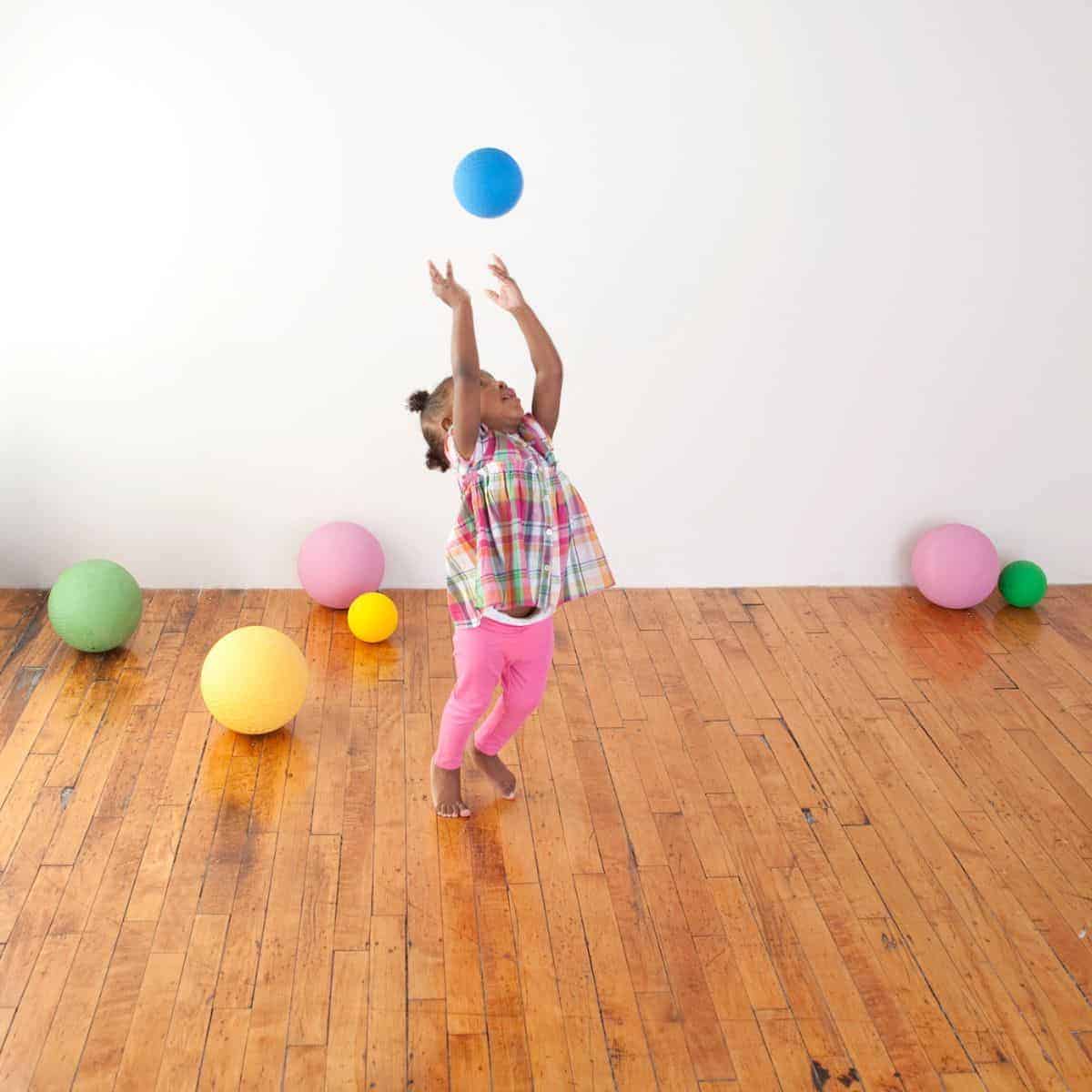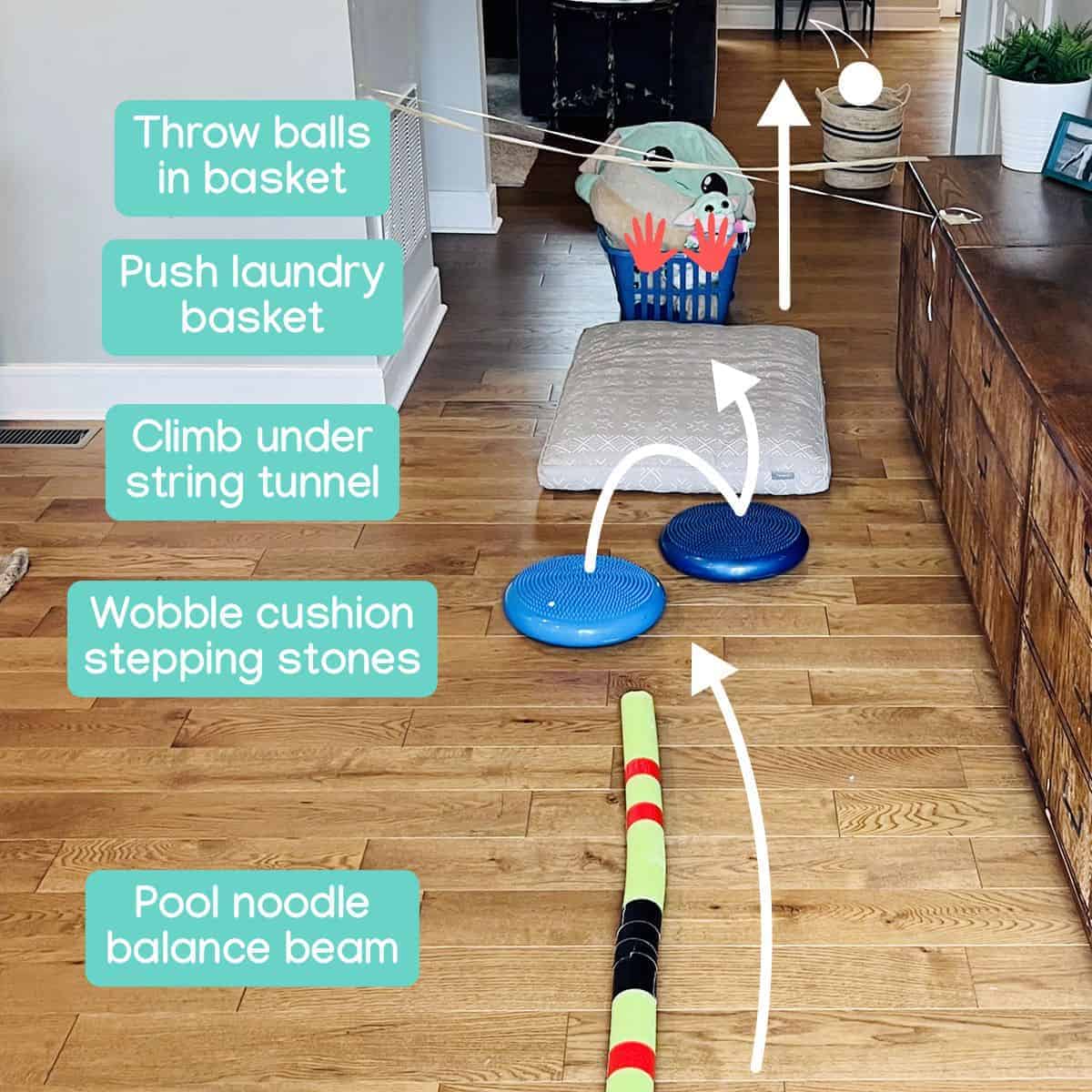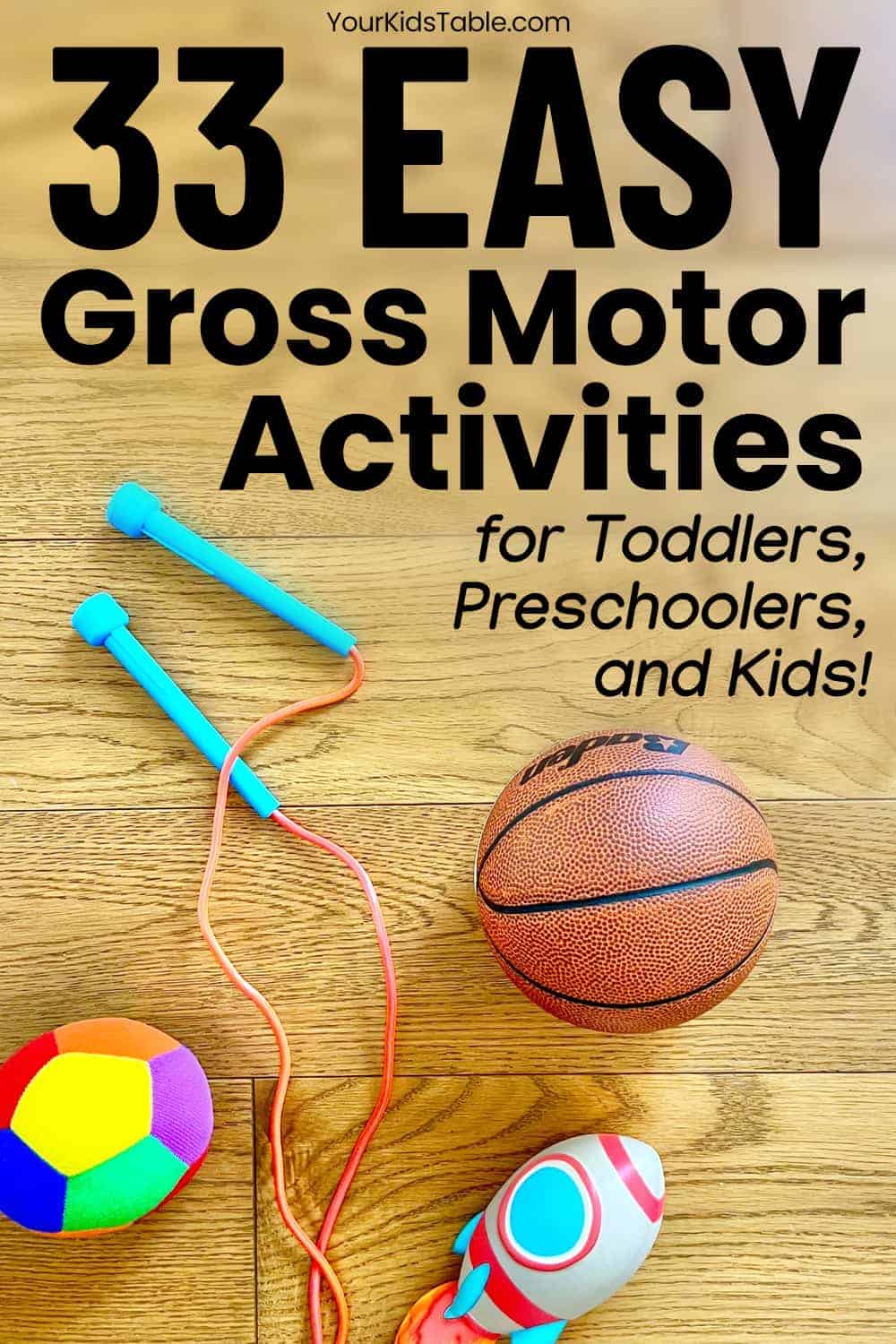Your kids will love these gross motor skill activities, for toddlers, preschoolers, kindergarten or school aged. Plus, benefits of gross motor activities. Tons of ideas to try for large motor!
Affiliate links used below. See our full disclosure.
Take even a short look at the kinds of things the average kid is into, and you will quickly see how important physical movement and physical activities are for development.
Playgrounds, climbing, running, crashing, riding bikes… it’s no doubt that kids love to move!
And learning valuable skills for building strength, muscle tone, and coordination are important in developing the large powerhouse muscles of the body that are the foundation for all movement.
As a pediatric occupational therapist, I and other OT’s tend to be more concerned with fine motor skills, sensory processing, and daily skills like eating.
But there is an undeniable connection between gross motor skills and all these other areas of development!
That’s why I’m glad you’re here, whether you’re a teacher, parent, or other professional working with kids, know that the time you spend on gross motor activities will be worth every minute!
Table of contents/Index:
- What’s an Example of a Gross Motor Activity?
- Types of Gross Motor Activities
- Benefits of Gross Motor Activities
- Gross Motor Development Timeline
- Gross Motor Activities List for all Kids
- Gross Motor Activities for Toddlers
- Gross Motor Activities for Preschoolers and Kindergarteners
- Gross Motor Activities to Help Sensory Processing
What’s an Example of a Gross Motor Activity?
Gross motor activities are activities, games, or movements that use the whole body, especially the large muscles.
Don’t let the word “activity” throw you off into thinking working on these skills needs to be complicated or even organized.
A gross large motor activity is any stand alone or combination of simple activities that challenges or uses the gross motor system and works on the strength and coordination of these muscles.
Outdoor gross activities, indoor gross motor activities, free play, and even DIY gross motor activities can all help work on these areas.
Gross motor skills are usually broken down into 3 types:
- Locomotive, or movement skills
- Stationary or stability, the skills used for balance, posture, etc.
- Manipulation, or the movement of the body using an object (like hitting a ball with a tennis racket).
This means that anything a child does using their whole body, from crawling, to running, to jumping, all count as gross motor activities! And, also includes walking across a balance beam or playing catch.
Keep reading for a ton of creative ideas for different ages
Benefits of Gross Motor Activities for All Ages
Gross motor activities can be simple all while giving your kid a boost to all sorts of areas of their development. When you work on gross motor skills you’re also working on:
- Motor planning (aka the “problem solving” we do to move our bodies around objects and safely though our environment)
- Balance
- Core and large muscle strength
- Hand-eye coordination
- Sensory processing
- Postural control
Gross Motor Development Timeline

Children develop in a specific sequence of skills starting in the womb that continues throughout childhood.
Typically this development starts at the center of the body and then moves outward.
Large muscles like our core, back, upper legs, and shoulders are closer to our centers; and smaller muscles like those in our hands, feet, and even mouths are farther away from our centers.
Because the body is so interconnected, it is important that there is stability, strength, and coordination of these “middle of the body” muscles before the distant ones like hand muscles follow suit.
This is why milestones like rolling over, standing, and walking typically come before milestones that require small movements like feeding themself, throwing a ball, and writing their name.
Let’s take a look at what you can expect:
- Hold head up with neck and core control (newborn-2 months)
- Roll over both ways (3-5 months)
- Sit up without support (6-8 months)
- Crawl or creep (6-11 months)
- Roll ball with 2 hands (6-11 months)
- Stand unassisted (10-12 months)
- Walk on own (11-15 months)
- Run (11-15 months)
- Climbing playground equipment/stairs (15-18 months)
- Tip-toe (15-18 months)
- Kick ball (15-18 months)
- 2-footed jumping (2 years+)
- Gallop (2 years +)
- Skip (3 years +)
- Jump on 1 foot (3 years +)
- Pedal a tricycle (3 years +)
- Ride Bike (4 years+)
This is a general list, and there are many small movements that come in between these steps, not to mention the brain and body connection that must occur to master any of these skills.
Also, this order can be affected if a child has a diagnosis, especially a motor disorder like dyspraxia
While the body being so closely tied together is a great thing when it comes to mastering all of these skills, it also gets complicated when one area is underdeveloped or challenged.
This is the case for many kids with sensory challenges like sensory processing disorder (SPD), and Autism (ASD) who tend to have more difficulty with gross motor skills.
For these kiddos, often some of the building blocks needed for these activities, like body awareness or adequate muscle tone are decreased.
Or avoiding or seeking certain physical activity or sensations get in the way of doing the movements correctly.
A good example of this is a sensory-avoidant child crawling and walking later than expected because they don’t like the way the texture of the ground feels on their hands and feet, so they are content without exploring.
Or in contrast, a sensory seeking kiddo might have poor personal space awareness and crash into his environment, making balance and coordination tasks like riding a bike more difficult.
But the good news is, these skills can improve and usually in a fun way! Since most kids have an internal drive to do these activities, addressing them is easier than you might think.
Whether you have young children or older children, getting their entire body moving will help build these skills. Now for the activities!
Gross Motor Activities For All Ages

We will start with a general list of activities for all ages, and then break down some specifics for toddlers, preschoolers, kindergarteners, and school-aged kids.
Since you know your child best, feel free to experiment with different activities depending on what they are working on. Gross motor activities for kindergarten, for example, could include anything from the list below.
- Throwing and catching a ball at target or to another person
- Obstacle course- make sure to include climbing, ducking under, and maneuvering around items for best benefits. See an example of an obstacle course.
- Kicking a ball to target or another person
- Relay race – set a start and finish line and call out an action to take as they move from the start to end such as: galloping, carrying a weighted ball, rolling, skipping, running, jumping, etc. You can change the action for each relay. Great for multiple kids, but can also be used one on one.
- Riding bike or scooter
- Running, jumping (jump rope, trampoline, over items, off of items) or climbing playground equipment
- Dancing, gymnastics, dance party, cheerleading, or hula hooping
- Animal walks, jumping jacks, hopscotch, or other proprioceptive activities
- Organized sports: basketball, soccer, baseball, tennis, volleyball, swimming, bowling etc.
- Log rolling, rolling down hill, or somersaults
- Simple workout classes like Zumba, aerobics, step
- Box maze – open the bottom of a few boxes that are big enough for a child to crawl through and push them together to make a tunnel for crawling through. This is great addition to an obstacle course.
- Tag and freeze-tag
- Charades, Simon Says, or acting out a story
- Roller skating/ roller blading
- Yoga poses for kids
- Bean bag toss/corn hole
- Use a rope to play tug of war and limbo
- Bat a balloon back and forth – to make this gross motor activity more challenging and build core strength, play on knees.
*The ideas for younger kids below can also be used for older kids who often love these types of games longer than adults tend to think they do.
Gross Motor Activities For Toddlers
- Crawling, crouching, or belly crawling through a tunnel or cardboard box
- Climbing furniture and jumping onto cushions
- Pedaling a tricycle, scooter board, or pushing/pulling a wagon or laundry basket

- Riding or pushing a push toy
- Bending at waist, squatting down to pick up items and place in basket (like easter egg hunt)
- Clapping hands to songs, popping bubbles
- Using a parachute (at least 2 people), encouraging kids to lift up in the air, bounce a ball around on top, and run underneath when it’s lifted up.
- Red light “stop” and green light “go” and other simple action songs like “row, row, row your boat” or “I’m a little teapot”
Gross Motor Activities for Preschoolers and Kindergarteners
- Group movement games like: ring around the rosie, simon says, head, shoulders, knees, toes, duck, duck, goose, The floor is lava, etc.
- Relay-style races like: Egg and spoon race, wheelbarrow, 3-legged race

- Build a fort, obstacle course, or do a scavenger hunt, including multiple parts like: stepping stones, walk across a log or balance beam, etc.
- Keeping a balloon in the air, hit back and forth, or at target
- Hide and seek
- Galloping, hopping, or skipping across the room – Can combine with a game like “Mother May I” in which you give a different instruction for so many steps. For example you can say, “Hop 5 times.” Followed by “Skip until I say stop,” or “Gallop 3 times.”
- Dress up, pretend play with costumes
- Fly a kite or use a stomp rocket, or throw and chase a paper airplane
- Paper plates skating – place paper plates under the balls of feet and move around. Kids can place heels down at any time they feel unstable to catch their balance.
There you have it! A child’s gross motor skills are truly foundational to the rest of their physical development, and in turn, their fine motor development and sensory processing.
Remember to keep it simple, and use indoor activities, outdoor activities, and follow your child’s interest to get them involved!
And if you’re concerned you might need professional help, ask your doctor for a referral to a pediatric physical therapist or an occupational therapist who can give you some specialized advice.
Need More Help Getting Your Sensory Kid Interested in Physical Activities?
As mentioned above, some kiddos with sensory sensitivities will find gross motor skills and activities hard, or will even avoid them which keeps them from practicing and working on these valuable skills.
In this case, it can help to first address some of the sensory issues going on.
Sensory activities can be a great stepping stone for your child to break down that barrier so they can regulate themselves to then learn some of these other important skills.
Grab our free list of 25+ sensory activities in our Sensory Essential Printable.
Laura Mau is a licensed occupational therapist and member of the Your Kid’s Table team. She has over 8 years of clinical experience in helping families navigate complex feeding and eating, sensory processing, and reaching developmental milestones with their children. She currently practices in Colorado and has 2 young kids of her own.
Alisha Grogan is a licensed occupational therapist and founder of Your Kid’s Table. She has over 19 years experience with expertise in sensory processing and feeding development in babies, toddlers, and children. Alisha also has 3 boys of her own at home. Learn more about her here.



I loved this post! The activities are so creative and seem really fun for my little ones. Can’t wait to try the obstacle course in the backyard this weekend! Thanks for the great ideas!